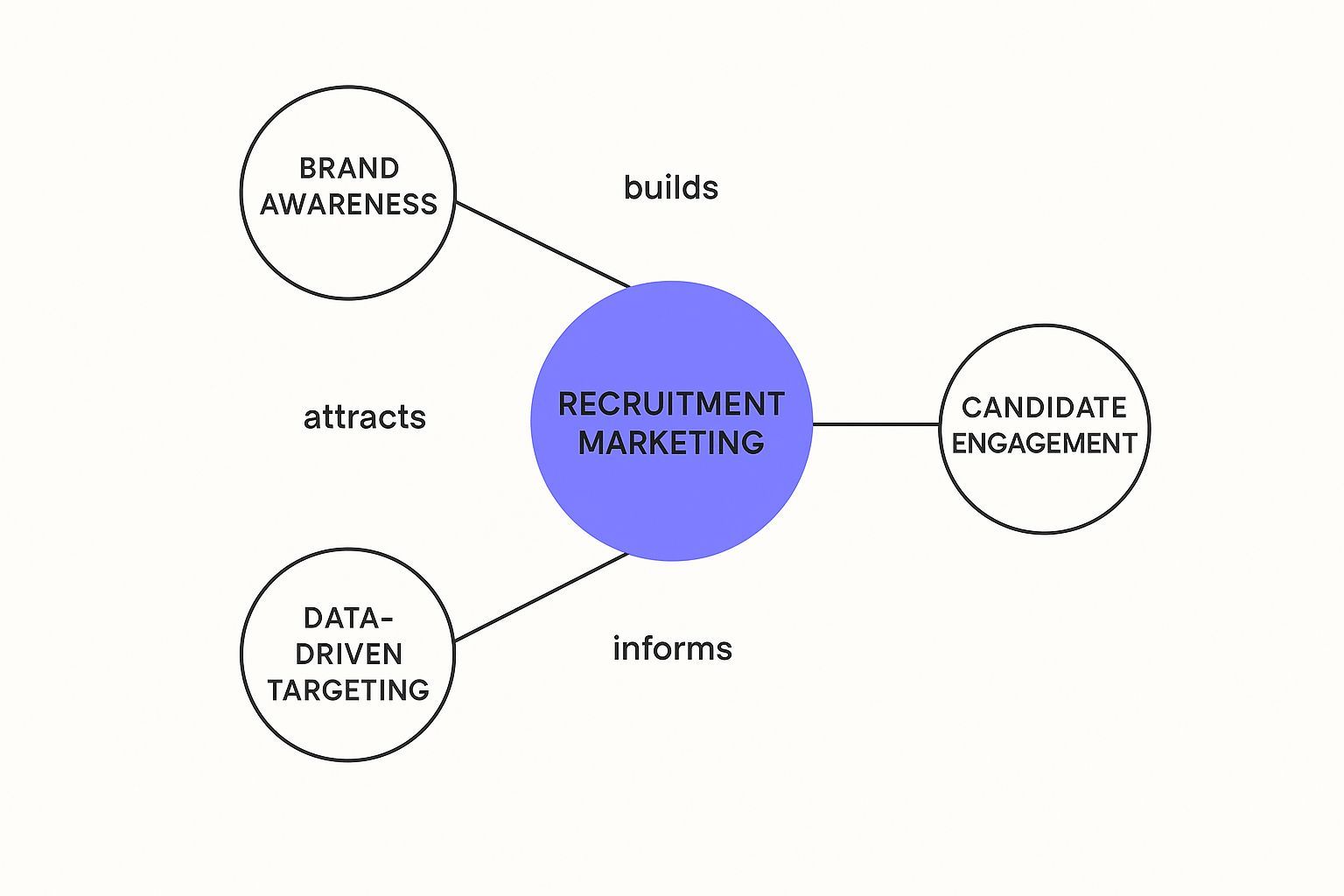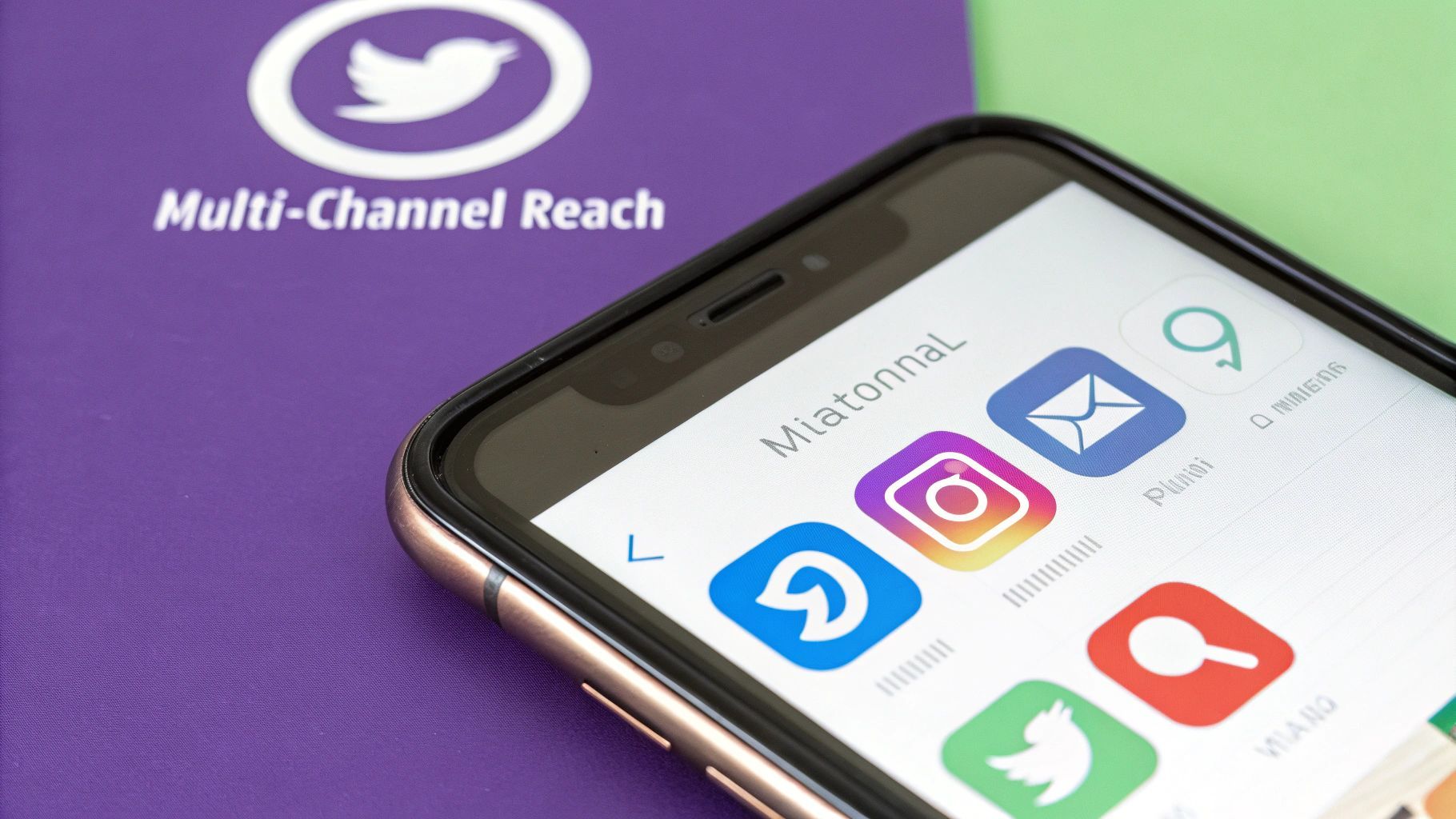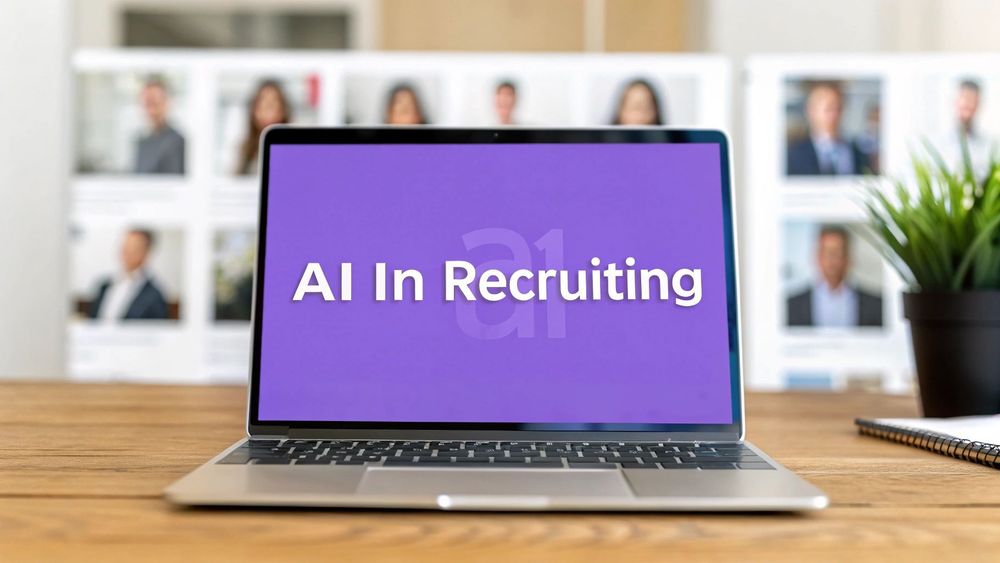So, what exactly is recruitment marketing? Put simply, it’s about using proven marketing tactics to find, attract, and nurture the right talent for your company.
It’s a complete shift away from the old-school, reactive way of hiring—where you post a job and just hope the right people apply. Instead, recruitment marketing is a proactive strategy that focuses on building relationships with potential candidates long before you even have a job opening.
This approach flips the script entirely. It treats candidates like customers, working to build such a strong employer brand that your company becomes a top choice for both active and passive job seekers.
Shifting from Reactive to Proactive Hiring
Think of traditional recruiting like fishing with a single line. You cast it out (post a job opening) and wait. You might get a bite, but you’re only catching the fish that are hungry and actively looking for food at that very moment. It’s a game of chance and a common challenge for hiring teams.
Recruitment marketing, on the other hand, is like becoming the entire coral reef. You’re not just casting a single line; you’re building a vibrant, appealing ecosystem—your employer brand—that naturally attracts the best talent. This creates a healthy pipeline of skilled professionals who are already interested in your company, giving you a pool of warm leads to tap into the second you need them. This proactive stance overcomes the limitations of waiting for candidates to come to you.
What Makes Recruitment Marketing Different
The real difference is that recruitment marketing is a long game. It's not about a single, short-term transaction to fill one role; it's about continuously building relationships. For a deeper dive into modern hiring strategies, you can explore our other articles on talent acquisition.
This visual breaks down the core pieces that make this strategy work.

As you can see, success hinges on blending brand awareness with genuine candidate engagement and using data to make sure you're reaching the right people.
Recruitment Marketing vs Traditional Recruiting At a Glance
To make the contrast even clearer, here’s a simple table highlighting the fundamental differences between these two hiring philosophies. It shows just how much the goals, timeline, and core activities change when you adopt a marketing mindset.
| Aspect | Traditional Recruiting | Recruitment Marketing |
|---|---|---|
| Focus | Transactional (fill an open role) | Relational (build a talent pipeline) |
| Timeline | Short-term (starts when a job opens) | Long-term and continuous |
| Target | Active job seekers | Active and passive candidates |
| Goal | Make a hire | Build an employer brand |
| Primary Tactic | Job postings and applications | Content, social media, and CRM |
Ultimately, moving from a reactive to a proactive approach isn't just a small tweak—it's a strategic advantage that fundamentally changes how you attract and retain top talent.
The Pillars of a Powerful Recruitment Marketing Strategy

A winning recruitment marketing strategy isn’t something you can just slap together with a single tactic. It's a carefully constructed machine, with several interconnected parts working together to pull in top talent.
Just like any good marketing effort, it all starts with knowing who you're talking to. You have to get inside the heads of your ideal candidates. Learning how to research your target audience effectively is the first step to crafting messages that actually land.
Once you know your audience, you can build your strategy around four essential pillars. Each one has a specific job to do—from catching a candidate's eye to turning them into your next great hire.
Employer Branding: The Foundation
Your employer brand is basically your company's reputation as a place to work. It’s what people think and say about your culture, your values, and what it’s really like to be on your team. A strong employer brand is the bedrock of your entire strategy because it answers a candidate's biggest question: "Why would I want to work here?"
This is all about showing off what makes you special—your mission, your vibe, your commitment to work-life balance, and the real career opportunities you offer.
Think of it this way: a strong employer brand can slash your cost-per-hire by up to 50% and cut turnover rates by 28%. This isn't just fluffy stuff; it's a hard-hitting business asset that directly impacts your budget and your ability to compete for the best people.
Content Marketing: The Story
Content marketing is how you breathe life into your employer brand. It’s about creating and sharing genuinely useful and interesting content that pulls back the curtain on your company.
This isn’t about just blasting out job ads. It’s about storytelling. You're building trust and making a human connection long before someone even thinks about applying.
What does this look like in action?
- Employee Spotlights: Short blog posts or videos where current team members share their real stories and career paths.
- "Day in the Life" Videos: Gritty, authentic clips showing what a day actually looks like in a specific role. No gloss, just reality.
- Culture Articles: Posts that talk about your company values in action, your diversity programs, or that time the whole team went axe-throwing.
Social Media Recruiting: The Conversation
Let's be real—your ideal candidates are already scrolling through social media. This makes it the perfect place to start a conversation. This pillar is about so much more than just posting job openings. It’s about building a community.
When you share your content, jump into industry chats, and highlight your team's successes, you start building real relationships. You'll connect with a huge network of professionals, including those passive candidates who aren't even looking for a job... yet.
Candidate Relationship Management: The Nurturing
Think of Candidate Relationship Management (CRM) as the engine that keeps your talent pipeline warm. It’s the system and the strategy you use to stay connected with potential hires over the long haul.
With a good CRM, you can keep track of every interaction, organize candidate info, and send out personalized messages that keep your company on their radar. When the perfect role finally opens up, you won't be starting from scratch. You'll already have a pool of engaged, qualified people who are ready to talk, which massively cuts down your time-to-hire.
Why You Must Engage the Hidden Talent Pool

If your recruitment strategy is laser-focused on active job seekers, you’re missing the forest for the trees. The truth is, the most skilled, accomplished professionals in your field probably aren't scrolling through job boards. They're already employed and doing great work.
This is the hidden talent pool—the world of passive candidates.
These folks aren't polishing their resumes or hitting "apply," but that doesn't mean they're not open to something better. Tapping into this group isn't just a good idea; it's a non-negotiable part of modern recruiting. It requires a total mindset shift, moving from passively waiting for applications to proactively building relationships with the best people in your industry.
The Sheer Size of the Passive Candidate Market
The numbers here are genuinely staggering. It turns out that a whopping 73% of the entire job market is made up of these passive candidates. And get this: an incredible 87% of them are open to hearing about a new job offer if the right one comes along.
Let that sink in. The best person for your open role is almost certainly not looking for a job right now. By ignoring this massive group, you’re stuck competing with every other company for the same small slice of active candidates. That drives up competition and can seriously dilute the quality of your hires.
How to Reach the Unreachable
So, how do you connect with people who aren’t looking for you? You have to go to them. This isn’t about spamming inboxes; it’s about a smarter playbook built on personalized outreach, valuable content, and a magnetic employer brand. The goal is simple: get on their radar long before they even think about making a move.
Here are a few practical ways to do it:
- Create Targeted Content: Write articles, record videos, or share case studies that speak directly to the challenges and interests of professionals in your target roles. Share this on platforms like LinkedIn, where they already spend their time.
- Make Outreach Personal: Generic, templated messages are a dead end. Do your homework. Reference their specific skills, a project they worked on, or a recent accomplishment. Show them you've put in the effort.
- Showcase Your Culture: Use your social channels and careers page to give people a real glimpse into what it's like to work at your company. Give them a reason to be curious.
For recruiters, this proactive approach means building a deep bench of high-potential individuals before a role even opens up. However, the manual work involved—finding, copying, and organizing profiles—is a major bottleneck. This is where a tool like ProfileSpider becomes a game-changer.
With just a single click, ProfileSpider’s AI-powered engine extracts complete professional profiles from any website—whether it's LinkedIn, a niche industry forum, or a conference speaker list. It's a no-code solution that eliminates hours of tedious data entry. You can focus your time on what really matters: nurturing relationships. By identifying and organizing these passive candidates now, you’re building a pipeline that gives you an unbeatable competitive edge later. For a deeper dive, check out our guide on how to source candidates effectively.
Overcoming Today's Toughest Hiring Hurdles
The modern hiring landscape is a minefield. Companies aren't just competing for customers anymore; they're locked in a fierce battle for talent. Sticking with the old, reactive methods is like trying to win a Grand Prix with a flat tire—you're just not going to keep up.
This is exactly where recruitment marketing flips the script. It gives you a strategic playbook for building a resilient hiring process that can handle market swings and intense competition. Instead of scrambling when a key position opens up, you get to operate from a position of strength, armed with a pipeline of engaged, high-quality candidates who already know and respect your brand.
Standing Out in a Crowded Field
When every company is shouting about their open roles from the rooftops, how do you make sure your message actually gets heard? This is where a strong employer brand—a core piece of recruitment marketing—becomes your secret weapon. It’s what separates you from the pack and turns your company into a place where top talent wants to work.
A proactive marketing approach lets you tell your company's story in an authentic way. You can show off your unique culture, put a spotlight on career growth, and build a solid reputation as an employer of choice. This doesn’t just grab the attention of active job seekers; it also puts you on the radar of the massive passive talent pool, ensuring you attract people who are not just skilled, but a fantastic cultural fit.
Building Relationships at Scale
Recruiters are often stretched thin, juggling dozens of open roles and a flood of candidates. Trying to build genuine, one-on-one relationships can feel completely impossible. Recruitment marketing helps solve this by bringing in smart automation and nurturing campaigns that can work their magic at scale.
These campaigns empower busy recruiters to stay connected with a huge talent pool without losing that personal touch. By sharing relevant content and company updates, you keep your brand top-of-mind. So, when the perfect role finally opens up, you’re reaching out to a warm lead, not a cold contact. It’s a game-changer.
The internal strain on hiring teams is a real problem. Recent surveys show 51% of organizations see their own recruitment team's turnover as a major hurdle, while 42% report rising competition for talent. To fight back, 40% of talent acquisition leaders are doubling down on building stronger candidate relationships to improve communication and stop people from dropping out. You can dig into more details in these recruiting statistics.
This shift towards nurturing connections directly tackles the industry's biggest headaches. A fantastic candidate experience, powered by consistent and thoughtful communication, dramatically lowers the chances of top talent ghosting you. This proactive, marketing-driven approach is absolutely essential for building a hiring function that isn't just effective, but built to last.
How to Build Your Talent Pipeline in One Click

Putting recruitment marketing theory into practice means getting brutally efficient, especially in the "attract" phase. Let’s face it: building a talent pipeline by hand is a soul-crushing, tedious process that eats up hours you don't have. Manually copying and pasting names, job titles, and contact info from websites is not a good use of anyone's time.
The traditional method involves painstaking research on LinkedIn, industry forums, or event speaker lists, followed by transferring all that data, one field at a time, into a spreadsheet. This isn't just slow; it's a recipe for human error, leading to bad data and missed opportunities. It's a reactive bottleneck right where you need to be proactive.
Ditching Manual Data Entry for Good
Modern recruitment marketing moves too fast for manual methods. The real goal is to spend less time on admin grunt work and more time actually building relationships with potential hires. This is where automation becomes a recruiter's best friend.
Imagine you could land on any website and, with a single click, instantly extract every professional profile on the page. No more right-clicking, no more copy-pasting, and definitely no more manual data entry. That’s the entire idea behind a no-code tool like ProfileSpider, which puts your pipeline building on hyperdrive.
A strong talent pipeline is your greatest competitive advantage. It transforms recruiting from a reactive scramble to fill open roles into a strategic function that anticipates future hiring needs. Building this pipeline efficiently is the key to staying ahead.
The One-Click Workflow with ProfileSpider
ProfileSpider simplifies hours of manual work into a single click. It uses an AI-powered engine that automatically spots and extracts complete professional profiles from any website you're on—from social media platforms like LinkedIn to super niche industry directories.
The process couldn't be simpler:
- Navigate to a page loaded with professional profiles.
- Click the "Save Profiles" button in the ProfileSpider extension.
- Watch as the AI instantly pulls out names, job titles, companies, contact details, and social links.
All extracted data is stored locally in your browser, giving you complete privacy and data control. From there, you can organize prospects into custom lists, add tags to filter them later, and export everything directly to your CRM or ATS in professional formats like CSV or JSON. This workflow empowers you to build laser-focused candidate lists from pretty much anywhere on the web in seconds. To see how this fits into the bigger picture, check out our complete guide on how to build a talent pipeline.
Once you've got your pipeline humming, the next step is active engagement. Exploring practical tools like trendy LinkedIn templates can give your outreach a serious boost and help you connect with these new prospects in a way that actually gets a response.
Riding the Waves: Recruitment in an Uncertain Economy
When the economy gets choppy and hiring slows to a crawl, the knee-jerk reaction for many companies is to slam the brakes on all things recruitment. It seems logical, right? No open roles, no need to recruit. But this short-term thinking is a classic pitfall that can leave you scrambling to catch up when the tide inevitably turns.
A smarter approach is to think like a marketer. Instead of going completely dark, you can use these quieter periods to your advantage. It’s the perfect time to build relationships and keep your talent pipeline warm, even if you aren’t actively hiring. This isn't just a nice-to-have; it's how you build a resilient talent strategy that pays off in the long run.
How to Keep the Engine Running During a Slowdown
When active hiring is on hold, your recruitment marketing goal shifts. Forget about immediate conversions. The new name of the game is brand building and engagement. You want to stay top-of-mind, ensuring that when the hiring floodgates open again, you're the first company people think of.
This is your moment to double down on:
- Telling Your Story: Share what makes your company a great place to work. Highlight employee successes, dive into your unique culture, and offer up some industry insights. This isn't just noise; it’s about positioning your brand as a leader and a desirable employer.
- Building Your Community: Get involved where your ideal candidates hang out. Jump into online forums, host a webinar, or just engage with professionals on social media. It’s all about making connections without the pressure of trying to fill a specific role.
- Nurturing Your Talent Pool: That CRM full of past applicants and promising leads? Don't let it go cold. Send out periodic updates or share content they'll find genuinely useful. It’s about keeping that relationship warm, not letting it fade away.
Building Rock-Solid Trust When Candidates Are Wary
Let's face it: during an economic downturn, even the best professionals get nervous about switching jobs. A strong employer brand and a genuinely great candidate experience are no longer optional—they're what you need to build the trust that convinces someone to take a leap of faith.
When you consistently show off your company’s stability, culture, and commitment to its people, you’re making a powerful case for why you're a safe harbor in a storm.
The market data backs this up. We’ve seen a 5.8% drop in job volume in the U.S. over the last three months compared to this time last year. This trend signals that recruitment marketing has to adjust to longer hiring cycles and the reality that candidates are going to be more hesitant. You can dig deeper into these trends in the global recruitment market snapshot on Bullhorn.com.
Investing in your employer brand during a downturn is like saving for a rainy day. When the storm passes and hiring ramps back up, you'll have a reservoir of warm, engaged candidates ready to go, giving you a significant head start over competitors who went silent.
Your Top Recruitment Marketing Questions, Answered
Getting into recruitment marketing can feel like learning a whole new language. It's not as complicated as it seems, though. Once you grasp a few core ideas, it all starts to click. Let's tackle some of the most common questions recruiters have when they're just starting out.
How Is Recruitment Marketing Different from Employer Branding?
This is a big one, and it's easy to get them mixed up. The simplest way to think about it is this: your employer brand is who you are, and recruitment marketing is how you tell people about it.
Employer Branding is your company’s reputation as a place to work. It’s the foundation—your culture, your values, and the real-life experience of being on your team. It’s your identity, built from the inside out.
Recruitment Marketing is the action plan. It's all the stuff you do to get that identity in front of the right candidates. Think content, social media campaigns, targeted emails, and job ads that do more than just list requirements.
Your employer brand is the story; recruitment marketing is the storytelling. You can't have one without the other.
Can Small Businesses Actually Do This on a Tight Budget?
Absolutely. You don't need a six-figure budget to start thinking and acting like a marketer. Some of the most powerful recruitment marketing tactics cost next to nothing.
Budget-Friendly Tactics:
- Lean on Your People: Ask your team members to share their stories on LinkedIn or even in a quick blog post. Authentic, firsthand accounts are incredibly powerful, and they don’t cost a dime to create.
- Tune Up Your Careers Page: Is your careers page easy to find? Does it work on a phone? Does it actually give a feel for your company culture? Nailing these basics is a huge, free win.
- Get Social (For Real): You don't need a huge ad spend to make an impact. Share behind-the-scenes photos, celebrate team wins, and post company news on the platforms where your ideal candidates hang out. Consistency beats a big budget every time.
How Do I Know If Any of This Is Actually Working?
Measuring your return on investment (ROI) is crucial—it's how you prove that these efforts aren't just "fluff." But it's time to look beyond just the cost-per-hire.
The real shift in measurement is moving from purely transactional metrics to relational ones. You need to track not just how many people you hire today, but the long-term health of your talent pipeline and the strength of your employer brand.
Start by tracking a few key metrics that tell the whole story:
- Source of Hire: Where are your best hires really coming from? A specific social campaign? Your revamped careers page?
- Time-to-Hire: Are your proactive efforts actually shortening the time it takes to fill critical roles?
- Offer Acceptance Rate: Are more top candidates saying "yes" because they already know, like, and trust your brand before the offer even comes?
- Careers Page Conversion Rate: Of all the people who visit your careers page, how many actually take the next step and apply? This tells you if your messaging is hitting the mark.




